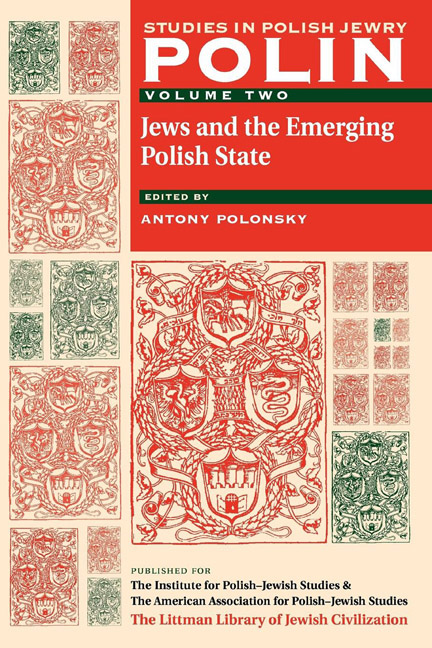Book contents
- Frontmatter
- Dedication
- Editors and Advisers
- Contents
- Polin: Studies in Polish Jewry
- Polin
- Statement From the Editors
- SYMPOSIUM: JEWS AND THE EMERGENCE OF AN INDEPENDENT POLISH STATE
- ARTICLES
- The Basic Privileges of the Jews of Great Poland as Reflected in Polish Historiography
- The Decline of the Polish-Lithuanian Kahal
- A Mobile Class. The Subjective Element in the Social Perception of Jews: The Example of Eighteenth Century Poland
- Polish Synagogues in the Nineteenth Century
- The image of the Jew in Polish Narrative Prose of the Romantic Period
- The Polish-Jewish Daily Press
- From ‘Numerus Clausus’ to ‘Numerus Nullus’
- DOCUMENTS
- COMMENTARY
- REVIEW ESSAYS
- BOOK REVIEWS
- Leiter to the Editors
- Contributors
- Obituaries
The Decline of the Polish-Lithuanian Kahal
from ARTICLES
- Frontmatter
- Dedication
- Editors and Advisers
- Contents
- Polin: Studies in Polish Jewry
- Polin
- Statement From the Editors
- SYMPOSIUM: JEWS AND THE EMERGENCE OF AN INDEPENDENT POLISH STATE
- ARTICLES
- The Basic Privileges of the Jews of Great Poland as Reflected in Polish Historiography
- The Decline of the Polish-Lithuanian Kahal
- A Mobile Class. The Subjective Element in the Social Perception of Jews: The Example of Eighteenth Century Poland
- Polish Synagogues in the Nineteenth Century
- The image of the Jew in Polish Narrative Prose of the Romantic Period
- The Polish-Jewish Daily Press
- From ‘Numerus Clausus’ to ‘Numerus Nullus’
- DOCUMENTS
- COMMENTARY
- REVIEW ESSAYS
- BOOK REVIEWS
- Leiter to the Editors
- Contributors
- Obituaries
Summary
Ever since Simon Dubnow, Israel Halperin and others established the central significance of Jewish autonomous institutions in the study of East European Jewish history, the kahal or kehillah (community as a corporate body) has been the object of continual attention. Some of the most recent works on Polish and Russian Jewry in the eighteenth and nineteenth centuries, while examining a wide range of issues, devote a good deal of discussion to the local Jewish community as a social phenomenon. Interestingly, the wider framework of Jewish corporate autonomy in Eastern Europe-the provincial and national va'adim (councils)-has not received the same kind of attention in recent years; nor has the question of the vitality and authority of the local kahal been linked to the question of joint or supra-communal activity.
Two main views have been expressed in the recent literature about the local kahal. Levitats and Shochat tend to regard state interference in and legal suppression of the kahal's official status as secondary to the empirical sociology of Jewish life in Eastern Europe. They emphasize the continuity and longevity of the kahal, or at least the hegemony of rabbis and lay leaders and the array of social and religious institutions active in communal life, well into the second half of the nineteenth century. Similarly, Stanislawski, while arguing that state pressure was a decisive factor in the way Jewish communal life evolved during the reign of Nicholas I, agrees that local communal rule - under another name - survived the official abolition of the kahal as such. The other view, taken by Rosman and Cohen, is that the kahal had lost most of its autonomy to the powerful Polish magnates and their officials long before the end of the eighteenth century.
At issue here is a larger question: that of continuity and change in the organizational aspects of East European Jewish society. Rosman and Cohen, for example, argue that the character of Jewish communal life underwent major changes in the period before the Polish partitions. Stanislawski, along with Levitats and Shochat, stress the basic stability in the Jews’ inner life prior to the third decade of the nineteenth century: a stability, they argue, which allowed the local community to shift gears when the shocks did come and was thus able to prolong its effective existence.
- Type
- Chapter
- Information
- Jews and the Emerging Polish State (Polin Volume Two) , pp. 150 - 162Publisher: Liverpool University PressPrint publication year: 2008

